Ceramic items—ranging from delicate vases and mugs to decorative tiles and porcelain figurines—are prone to chips, cracks, and breaks. When these mishaps occur, a high-quality ceramic glue can save your cherished pieces, restoring both their functionality and appearance. Unlike general-purpose adhesives, ceramic glues are specially formulated to bond non-porous, brittle surfaces securely without causing discoloration or leaving unsightly residue.
Choosing the right ceramic glue is essential for achieving a strong, durable repair. Factors like drying time, bonding strength, water resistance, and clarity of the adhesive can all affect the final result. Whether you’re repairing a favorite coffee mug, fixing a broken plate, or restoring a ceramic tile, selecting the best glue ensures your repair is not only strong but also long-lasting.
With so many glues available—epoxy, super glue, or specialized ceramic adhesives—knowing what to look for can be overwhelming. This guide will help you focus on the critical features that matter most, allowing you to choose the best ceramic glue for repairs with confidence.
Buying Guide: How to Choose the Best Ceramic Glue
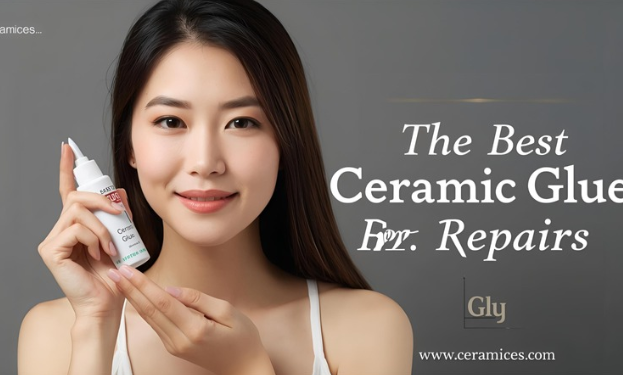
1. Bonding Strength
The primary purpose of ceramic glue is to hold broken pieces together permanently. Look for adhesives labeled as high-strength or industrial-grade, capable of withstanding stress, handling, and daily use without cracking or failing.
2. Type of Adhesive
- Epoxy: Two-part adhesives that provide extremely strong, durable bonds. Ideal for larger or load-bearing repairs.
- Cyanoacrylate (Super Glue): Fast-drying and convenient for small chips or decorative pieces.
- UV-Activated Glue: Cures quickly under UV light and often dries clear, making it perfect for visible or decorative repairs.
3. Drying Time and Cure Time
- Fast-drying glues are convenient for quick fixes but may have lower long-term strength.
- Epoxy and other two-part adhesives may require longer cure times but offer superior durability.
- Consider how much working time you need to align and adjust pieces before the glue sets.
4. Water and Heat Resistance
For items like mugs, plates, or kitchen tiles, the glue should be waterproof and heat-resistant. This ensures the repaired item can withstand washing, handling, and moderate temperature changes without breaking down.
5. Clarity and Finish
- Clear-drying adhesives are ideal for visible surfaces, ensuring that the repair is almost invisible.
- Some glues dry glossy, while others are matte; choose based on the aesthetic you want for the repaired item.
6. Ease of Application
- Glue that comes with a precision nozzle or brush allows for controlled application on small cracks and intricate shapes.
- Avoid glues that are too runny or thick, as they can be messy and affect the repair quality.
7. Durability and Longevity
High-quality ceramic glue should create a long-lasting bond that resists chipping, cracking, and aging. Look for products with reviews highlighting durability and performance under stress.
8. Safety Considerations
- Check for non-toxic formulas if you’re repairing items that come into contact with food.
- Wear gloves and ensure proper ventilation when using strong adhesives to avoid skin contact or inhalation of fumes.
👉 In summary, the best ceramic glue for repairs combines high bonding strength, water and heat resistance, clear-drying capability, and ease of use. Choosing the right glue ensures your cherished ceramic items are restored securely and elegantly, saving both their functionality and appearance.
I can now choose 6 top-rated ceramic glues from Amazon and write long descriptions with key features, pros, cons, and recommendations for each. Do you want me to do that next?
1. ATLASBOND Ceramic Glue – Super Clear, Food Safe
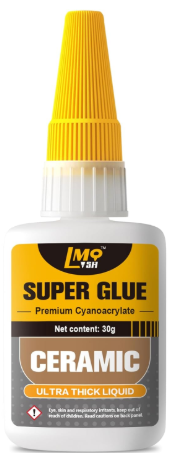
Description:
Designed specifically for repairing ceramics, porcelain, china, and pottery, this glue offers a strong, undetectable bond. Its food-safe adhesive formula ensures safety for items like mugs and cutlery.
Key Features:
- Sets in just 15 seconds
- Waterproof and heat-resistant
- Food-safe and non-toxic
- Includes 3 precision applicator tips
- Suitable for bonding ceramic to wood, glass, plastic, and more
Pros:
- Fast-setting for quick repairs
- Clear drying for invisible fixes
- Versatile use across multiple materials
Cons:
- May not be ideal for large or heavy-duty repairs
Recommendation:
Ideal for everyday ceramic repairs, especially for kitchenware and decorative items.
2. Ankita Ceramic Glue – Clear, Strong Bond
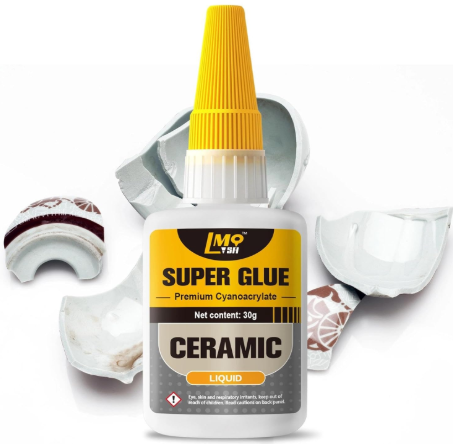
Description:
This glue is formulated for strong, durable bonds that can withstand temperature changes. It dries clear, ensuring no visible residue on repaired items.
Key Features:
- Strong and durable
- Temperature-resistant
- Clear drying formula
- Suitable for various ceramic materials
Pros:
- Reliable for both indoor and outdoor repairs
- Minimal drying time
- Transparent finish for seamless repairs
Cons:
- May require precise application to avoid excess glue
Recommendation:
Great for repairing ceramics exposed to varying temperatures, such as outdoor planters or decorative garden items.
3. cocomfix Ceramic Glue – Waterproof, Quick-Drying
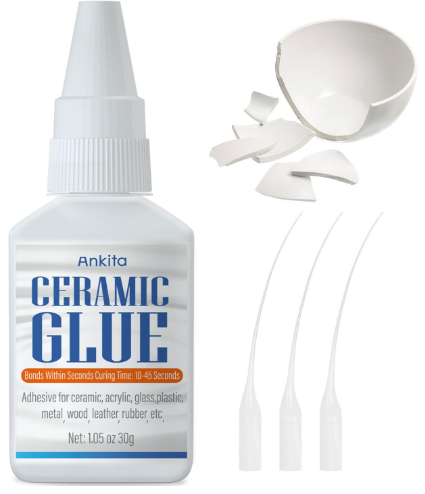
Description:
Specially developed for pottery, this glue offers excellent adhesion and quick drying. It’s particularly effective on porous surfaces.
Key Features:
- Great adhesion for pottery
- Quick-drying formula
- Waterproof
- Suitable for porous surfaces
Pros:
- Ideal for repairing ceramic items exposed to moisture
- Fast application and setting time
- Effective on a variety of ceramic materials
Cons:
- May not be as effective on non-porous surfaces
Recommendation:
Perfect for repairing outdoor ceramics or items frequently exposed to water, like birdbaths or garden statues.
4. Nexkayee Fast-Drying Ceramic Glue – Transparent, Multipurpose
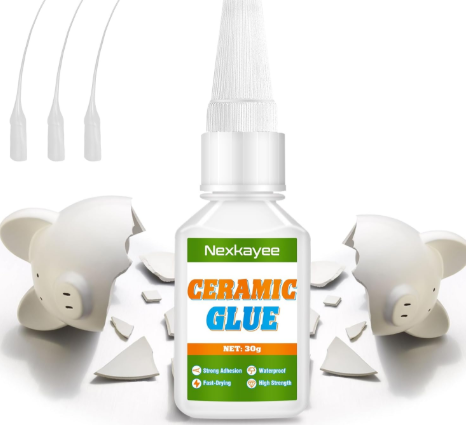
Description:
This glue dries quickly and forms a strong, lasting bond. It’s suitable for various ceramic materials and offers a transparent finish.
Key Features:
- Dries in 10 to 45 seconds
- Fully solidifies within 24 hours
- Waterproof
- Includes 3 droppers for precise application
Pros:
- Fast drying for efficient repairs
- Suitable for a wide range of ceramic items
- Clear finish for invisible repairs
Cons:
- Requires careful application to avoid excess glue
Recommendation:
Ideal for quick repairs on various ceramic items, including mugs, vases, and decorative pieces.
5. Vigorder Ceramic Glue Repair Kit – Waterproof, High Temperature Resistant
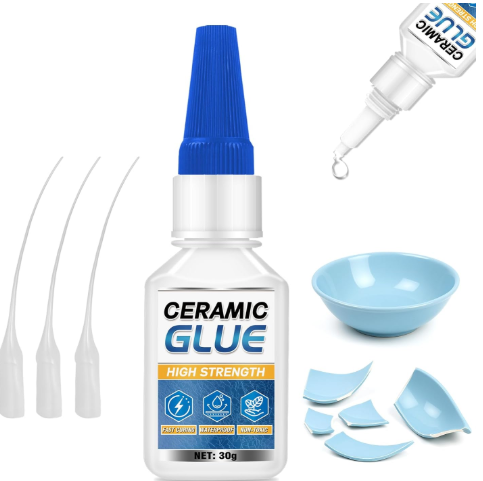
Description:
This repair kit is designed for fragile materials like ceramics and porcelain, offering strong bonding power and durability in harsh conditions.
Key Features:
- Strong adhesion
- Water and heat-resistant
- Sets in 15 to 30 seconds
- Food-safe adhesive
- Compatible with multiple materials
Pros:
- Durable in various environments
- Fast curing time
- Safe for food-contact items
Cons:
- May not be suitable for large-scale repairs
Recommendation:
Best for repairing kitchenware and other items exposed to heat and moisture.
6. Viomis 30g Ceramic Glue – Fast Drying, Heat Resistant
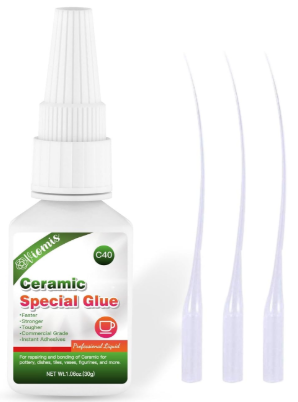
Description:
This glue offers fast drying and strong adhesion, making it suitable for various ceramic repair needs.
Key Features:
- Fast drying
- Heat resistant
- Strong adhesion
- Suitable for various ceramic materials
Pros:
- Quick application and setting time
- Effective on a variety of ceramic items
- Durable bond
Cons:
- Requires precise application to avoid excess glue
Recommendation:
Ideal for general ceramic repairs, including mugs, plates, and decorative items.
Comparison Table:
| Product Name | Drying Time | Waterproof | Heat Resistant | Food Safe | Best For |
|---|---|---|---|---|---|
| ATLASBOND Ceramic Glue | 15 seconds | Yes | Yes | Yes | Kitchenware, decorative items |
| Ankita Ceramic Glue | Moderate | Yes | Yes | Yes | Outdoor ceramics, garden items |
| cocomfix Ceramic Glue | Fast | Yes | Yes | Yes | Outdoor ceramics, water-exposed items |
| Nexkayee Fast-Drying Ceramic Glue | 10-45 seconds | Yes | Yes | Yes | Quick repairs on various items |
| Vigorder Ceramic Glue Repair Kit | 15-30 seconds | Yes | Yes | Yes | Kitchenware, heat/moisture-exposed items |
| Viomis 30g Ceramic Glue | Fast | Yes | Yes | Yes | General ceramic repairs |
Final Recommendation:
For quick and invisible repairs, ATLASBOND Ceramic Glue is an excellent choice. If you’re dealing with items exposed to outdoor elements, cocomfix Ceramic Glue offers durability and waterproofing. For general ceramic repairs, Nexkayee Fast-Drying Ceramic Glue provides versatility and ease of use. Always consider the specific requirements of your repair project, such as exposure to heat, moisture, and the need for food safety, to select the most suitable adhesive.
How to Use Ceramic Glue for Repairs
Using ceramic glue correctly ensures a strong, long-lasting bond and a clean repair. Follow these steps for best results:
1. Prepare the Surface
- Clean both surfaces thoroughly to remove dust, grease, or moisture.
- Dry completely before applying glue.
- For best adhesion, lightly sand rough edges if necessary.
2. Apply the Glue
- Use a precision applicator, nozzle, or brush for controlled application.
- Apply a thin, even layer to one side of the broken piece. Avoid excess glue, as it can ooze out when pressed together.
3. Join the Pieces
- Carefully align the broken pieces and press them together.
- Hold firmly for the time specified in the glue instructions (usually 15–60 seconds for fast-drying adhesives).
4. Allow to Cure
- Let the glue fully cure according to the manufacturer’s directions.
- Epoxy or two-part glues may require several hours to achieve maximum strength.
- Avoid moving or stressing the repaired piece during this period.
5. Clean Up Excess Glue
- Wipe away any excess glue immediately with a damp cloth or paper towel.
- For dried residue, gently scrape or sand, if safe for the surface.
Safety Guide for Ceramic Glue
✅ Do’s
- Work in a well-ventilated area to avoid inhaling fumes.
- Wear gloves to prevent skin contact with strong adhesives.
- Use precision tools to avoid accidental spills or over-application.
- Read and follow all manufacturer safety instructions.
- Keep glue away from children and pets.
❌ Don’ts
- Don’t ingest or apply glue to food surfaces unless it’s explicitly food-safe.
- Don’t mix glues from different brands or types.
- Don’t expose curing glue to heat, water, or stress until fully set.
- Don’t touch your eyes or skin after handling glue without washing hands.
Tips for Best Results
- Store glue in a cool, dry place with the cap tightly closed.
- Test the adhesive on a small, hidden area if unsure about compatibility.
- For visible repairs, choose clear-drying adhesives for a seamless finish.
- Use clamps or tape to hold pieces together for stronger bonds if needed.
By following these steps and safety guidelines, you can achieve strong, durable, and visually clean repairs on ceramic items while minimizing risk to yourself and your environment.
Frequently Asked Questions (FAQs) About Ceramic Glue
1. Is ceramic glue safe for items that touch food?
Yes, some ceramic glues are labeled as food-safe. Always check the packaging to ensure the glue is approved for kitchenware like mugs, plates, or bowls.
2. Can ceramic glue be used on porcelain, pottery, or tiles?
Absolutely. Most high-quality ceramic glues bond well with porcelain, pottery, china, and tiles. Some are versatile enough to adhere to glass, wood, and plastics as well.
3. How long does ceramic glue take to set and cure?
- Fast-drying glues can set in 15–60 seconds and reach full strength in 24 hours.
- Two-part epoxies may require longer curing times but provide stronger and more durable bonds.
4. Can I use ceramic glue on broken items that will be washed?
Yes, choose a waterproof and heat-resistant glue for items like mugs, plates, or outdoor ceramics to ensure the repair withstands washing and temperature changes.
5. Why is my ceramic repair visible?
Some visibility is normal if excess glue oozed out during repair or the bond line is thick. Using clear-drying adhesives and precise application techniques helps make repairs less noticeable.
6. Can I use ceramic glue for structural repairs?
Yes, epoxy-based or industrial-strength glues are suitable for load-bearing repairs, like fixing large vases or tiles. For decorative items, standard super glues or quick-set adhesives are usually sufficient.
Conclusion
A high-quality ceramic glue is an essential tool for restoring broken or chipped ceramic items, from kitchenware to decorative pieces. Choosing the right adhesive ensures strong, durable, and virtually invisible repairs, allowing you to extend the life of your favorite items and save money on replacements.
When selecting a ceramic glue, consider factors like bonding strength, drying time, water and heat resistance, clarity, and ease of application. Fast-setting glues are convenient for quick fixes, while epoxies or two-part adhesives offer superior durability for larger or functional repairs.
With the proper ceramic glue and careful application, you can confidently repair cherished ceramics, restore their original appearance, and ensure they remain safe and functional for everyday use.